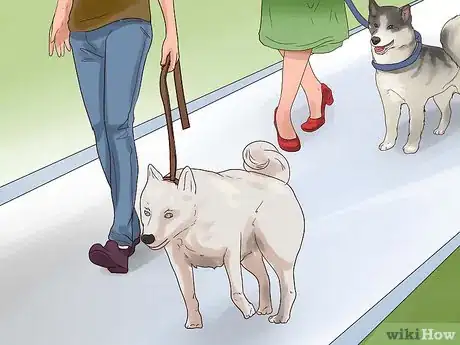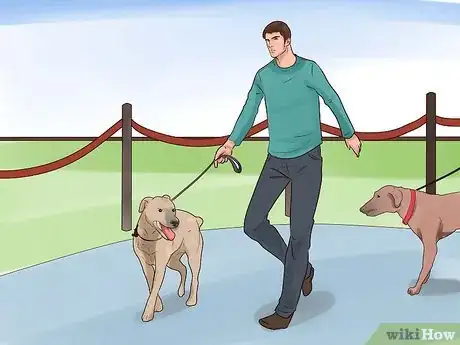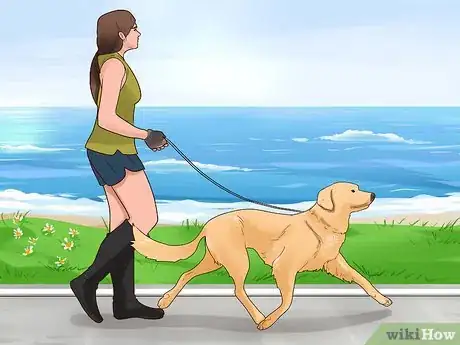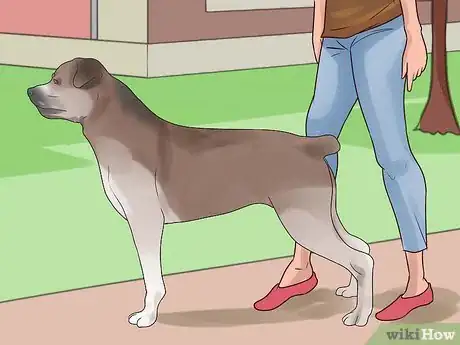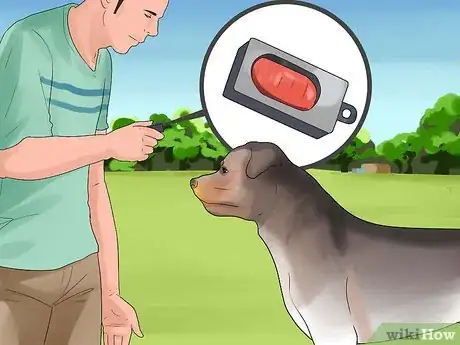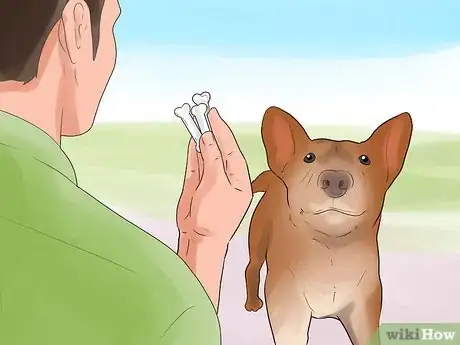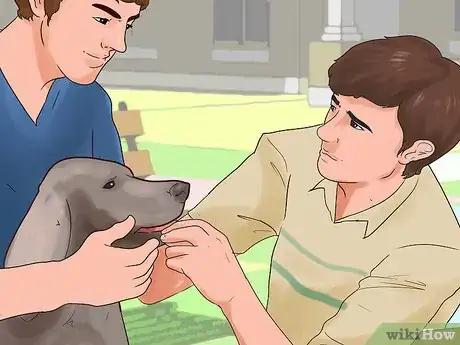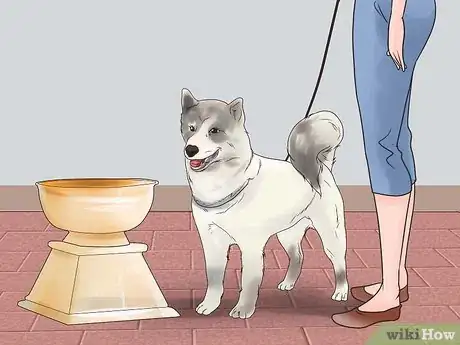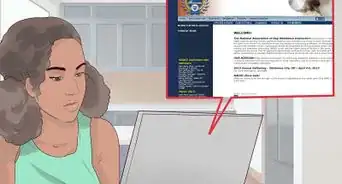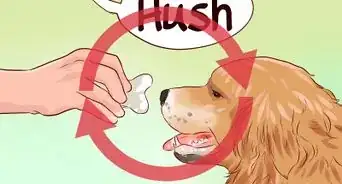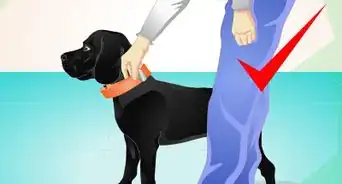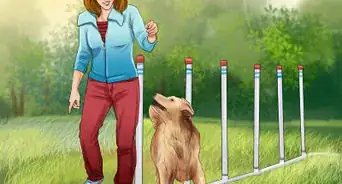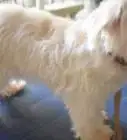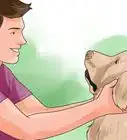This article was co-authored by Pippa Elliott, MRCVS. Dr. Elliott, BVMS, MRCVS is a veterinarian with over 30 years of experience in veterinary surgery and companion animal practice. She graduated from the University of Glasgow in 1987 with a degree in veterinary medicine and surgery. She has worked at the same animal clinic in her hometown for over 20 years.
There are 12 references cited in this article, which can be found at the bottom of the page.
wikiHow marks an article as reader-approved once it receives enough positive feedback. In this case, 80% of readers who voted found the article helpful, earning it our reader-approved status.
This article has been viewed 469,154 times.
Showing dogs, or "conformation" is a popular and enjoyable activity for many dog owners. It gives you a chance to build a stronger bond with your dog, and also to show off your canine friend to an adoring public. But, before your dog can trot to success, you need to train it for the stage so it can steal the show. This will be easiest if you begin when your dog is still a puppy.
Steps
Getting Ready to Train
-
1Make sure your dog is eligible to participate. Before you invest a lot of time and effort in training your dog, you will want to make certain your dog will be allowed to take part in dog shows.
- Only purebred dogs over six months old that are not spayed or neutered may take part in American Kennel Club (AKC) shows. That's because the purpose of these events is to judge whether your dog is good breeding stock.[1]
- Your dog must also be registered as a purebred with the appropriate breed club and conform to all breed guidelines.[2] If you got your dog from a breeder, they probably gave you the certification paperwork showing your dog is registered. If not, you'll need to contact the appropriate breed club. The AKC has an online directory you can use to contact the club.[3]
- If your dog is spayed or neutered, there are other events you can take part in. The United Kennel Club (UKC) has an "altered" class that allows these dogs to compete.[4]
- If your dog is not a purebred, it can compete in shows organized by mixed breed dog clubs.[5]
-
2Attend some dog shows. The next step is to attend some dog shows to get a better sense of what it's all about.[6]
- This will help you get a better sense of what judges are looking for, and what you can expect when you enter your dog.[7]
- This is also a great way to get more information about the show process and preparing your dog. Visit the club table or tent to pick up information on entering your dog and training classes offered by the club.[8]
Advertisement -
3Get the right lead. When your dog walks out into the ring, you'll need to have it on the right kind of leash or "lead." The sooner you get one of these, the sooner your dog can get comfortable with being on it. Go online or ask at your local pet store for one of these:
- For small dogs, you can use a Resco “all in one” style collar with lead. The Resco is a loop with a slider to keep it snug on the dog’s neck. [9]
- For a medium sized dog, you can use a martingale lead. These leads close up enough to keep your dog's head from slipping out, but don't tighten around a dog's neck like a choke-chain.[10] They also help to train your dog to keep its head held up high while showing judges their gait, and while stacking.
- The other commonly used lead is the chain and show lead. This is not as elegant as the martingale, but many handlers use them for larger, boxer breeds such as the Rottweiler. These also help your dog to keep its head held high, and to not run away in the ring.
-
4Enter your dog in a local ring raft class. These classes help you train your dog for a show. Although this is not necessary, it is recommended.
- Ringcraft classes can help you socialize your dog to other people and dogs. They can also help the dog learn to walk on a lead without being distracted by other dogs.[11]
- These classes can also be a great source of information about shows and showing. They can be a good opportunity to meet other people involved in showing dogs.[12]
Training your Dog for Show
-
1Practice gaiting. Gaiting is moving your dog in a way that allows the judge to see their movement and structure. The correct gait is usually a trot, with the dogs head up.
- A trotting dog’s right front leg and left back leg move forward at the same time, then the left front with the right back.[13] Trotting is the correct pace because it shows the dog’s true structure the best.
- To start, use treats to lure your dog to follow you around without a lead. The dog should remain at your left side.
- Once the dog is comfortable wearing the collar and walking beside you, formal lead training can begin. Attach a show lead to the dog's collar, pick up the dog and carry it a short distance away from your home. Put it down and walk back toward your house at a speed that encourages the dog to trot, holding the other end of the lead. The dog should be happy to go toward home and follow you. Repeat this process, carrying the dog farther away from home each time.
- If your dog fights the lead, back away and offer it treats to come toward you.
-
2Teach your dog to “hand stack.” To succeed, all dogs must learn to "stack," or stand squarely and still. In hand stacking, you manually place each leg in position while standing or kneeling close to the dog.
- Dogs will have to stack several times during a show. Many people let dogs "free stack" most of the time, but hand stack right before the judge's examination. This ensures the best possible stance for the dog.[14]
- The specific position your dog should be in will vary by breed. Consult the guidelines for your breed, available from the appropriate club.[15]
- To train for hand stacking, keep a good-sized treat in your right hand. Keep it partially covered so the dog can only nibble on it as you adjust the positions of the dog's feet with your left hand.
- Adjust the dog's front legs first, moving them at the elbow. Then, keeping your left hand on the dog at all times, move to the back legs and adjust them at the hock. Never stack by touching the dog's feet, as this may cause it to shift its whole body. Repeat this until your dog is comfortable with the process.[16]
- Finally, teach the dog to maintain that position. Pull the food away for a second and tell the dog to stay. If it holds the position, say "yes!" and give the dog a nibble of the food. If it doesn't, restack the dog and try again.[17]
-
3Teach your dog to "free stack." Free stacking is when your dog assumes the proper position on command, rather than with manual adjustment. This is most easily done with some training treats and clicker.
- To begin with, click and reward your dog whenever it stands. If it keeps standing, reward it again. Keep doing this until the dog offers the stand position spontaneously.[18]
- Next teach “back up.” Step toward the dog and click and treat any shift of movement backward, which should result in the dogs back legs aligning. Repeat this process with the command, clicking and reward increasingly correct backing up behavior.[19]
- Then, teach the dog to align its front legs with the command "step." To teach this command, step back and click and treat as soon as the dog moves a front foot forward. Once the dog does this easily, say “step” just before you prompt it. Repeat this until the dog aligns it's front feet on command.[20]
- Finally, teach the command "stack." Click and treat every time the dog is in the correct position. Repeat if the dog holds that position. Eventually, you'll be able to just use the "stack" command without "back up" and "step."[21]
-
4Bait train your dog. You want your dog to also look alert and happy when stacked. Most breeds should have their attention on the handler and the judge, and have their ears perked and their eyes on you.
- Training your dog to look at you is something you can begin the first time you feed the dog a meal. When you put the food bowl down, repeat the word “cookie" over and over. This repetition will teach the puppy to associate a food with that word.
- Later, use this command to focus your dog's attention on you while offering it treats from your hand when it is in a stacked position. This causes the dog stretch its neck upward to look at you. This pose shows the dogs outline and balance to the judge.
-
5Teach the dog tolerate examination. In a dog show, judges will physically examine a dog, touching its body and mouth. A successful show dog will need to tolerate this without complaint.
- A good first step in getting your dog accustomed to this is to to touch the dog all over its body daily, including inside its mouth. If you start this at a young age, your dog will quickly grow accustomed to it.[22]
- Next, begin giving your dog regular inspections that approximate those of a judge. Closely examine the dog's teeth. For males, touch the testicles.[23] Do this on both a table and the floor, if your dog is smaller in size. While small dogs are usually inspected on a table, some judges will begin inspection while the dog is still on the ground.
- Finally, when the dog is comfortable with your inspections, bring in a second person and ask ask them to do the same. This way, your dog will get comfortable with inspection by strangers.
-
6Start showing for local clubs. Before you try taking your dog to a major club show, try showing your dog with a small, local club. This can be fun, and a good way to determine if your dog is ready for the "big leagues."[24]
Expert Q&A
Did you know you can get expert answers for this article?
Unlock expert answers by supporting wikiHow
-
QuestionHow can I keep my dog cool?
 Pippa Elliott, MRCVSDr. Elliott, BVMS, MRCVS is a veterinarian with over 30 years of experience in veterinary surgery and companion animal practice. She graduated from the University of Glasgow in 1987 with a degree in veterinary medicine and surgery. She has worked at the same animal clinic in her hometown for over 20 years.
Pippa Elliott, MRCVSDr. Elliott, BVMS, MRCVS is a veterinarian with over 30 years of experience in veterinary surgery and companion animal practice. She graduated from the University of Glasgow in 1987 with a degree in veterinary medicine and surgery. She has worked at the same animal clinic in her hometown for over 20 years.
Veterinarian Take plenty of water and offer the dog drinks at regular intervals. You can also buy chill vests, which you either place in the freezer or slide ice packs into the panniers on either side of the vest. Put the chill vest on him when not actively in front of the judges. It also helps to teach him a command such as 'Look' that distracts him from getting over excited.
Take plenty of water and offer the dog drinks at regular intervals. You can also buy chill vests, which you either place in the freezer or slide ice packs into the panniers on either side of the vest. Put the chill vest on him when not actively in front of the judges. It also helps to teach him a command such as 'Look' that distracts him from getting over excited. -
QuestionMy Pit Bull was very aggressive in the ring. What should I do?
 Pippa Elliott, MRCVSDr. Elliott, BVMS, MRCVS is a veterinarian with over 30 years of experience in veterinary surgery and companion animal practice. She graduated from the University of Glasgow in 1987 with a degree in veterinary medicine and surgery. She has worked at the same animal clinic in her hometown for over 20 years.
Pippa Elliott, MRCVSDr. Elliott, BVMS, MRCVS is a veterinarian with over 30 years of experience in veterinary surgery and companion animal practice. She graduated from the University of Glasgow in 1987 with a degree in veterinary medicine and surgery. She has worked at the same animal clinic in her hometown for over 20 years.
Veterinarian There is no easy answer I'm afraid. Try and identify what exactly he's reacting to. Is it the presence of other dogs? If this is the case then you need to train him to tolerate their presence by rewarding him when he's calm around others. This is done by exposing him to a dog sufficiently far away that he doesn't react. Then reward his calmness. Have the other dog take a step closer, and then reward yours when he's good. In the show ring with lots of dogs in a small space this is going to be a big ask for him, and you may need the help of a trained behaviorist.
There is no easy answer I'm afraid. Try and identify what exactly he's reacting to. Is it the presence of other dogs? If this is the case then you need to train him to tolerate their presence by rewarding him when he's calm around others. This is done by exposing him to a dog sufficiently far away that he doesn't react. Then reward his calmness. Have the other dog take a step closer, and then reward yours when he's good. In the show ring with lots of dogs in a small space this is going to be a big ask for him, and you may need the help of a trained behaviorist.
Warnings
- Make sure you bring your dog's registration papers (for the kennel club), its vaccination papers, and its pedigree papers before going to the show. Otherwise, you may not be allowed to participate.⧼thumbs_response⧽
- Never drag a dog on the lead. Making the dog unhappy will only prolong the training process. It may take several weeks to train a puppy to trot on a lead.⧼thumbs_response⧽
- Some people believe that you should not teach show dogs to sit. This is because the dog may sit in the ring. This is especially likely if you practice more sits than stands. If you reinforce standing often, this reduces the likelihood of this happening.[25]⧼thumbs_response⧽
References
- ↑ http://www.akc.org/events/conformation-dog-shows/
- ↑ http://www.akc.org/events/conformation-dog-shows/faq/
- ↑ https://www.apps.akc.org/apps/clubs/search/index.cfm?action=national&display=on
- ↑ http://www.ukcdogs.com/Web.nsf/WebPages/DogEvents/Conformation
- ↑ http://www.dogingtonpost.com/mixed-breed-dog-clubs-of-america/
- ↑ http://www.akc.org/events/conformation-dog-shows/getting-started-showing/
- ↑ http://www.thekennelclub.org.uk/activities/dog-showing/new-to-dog-showing/
- ↑ http://www.akc.org/events/conformation-dog-shows/getting-started-showing/
- ↑ http://www.whole-dog-journal.com/issues/12_10/features/Positive-Training-For-Show-Dogs_16168-1.html
- ↑ http://www.whole-dog-journal.com/issues/12_10/features/Positive-Training-For-Show-Dogs_16168-1.html
- ↑ http://www.thekennelclub.org.uk/activities/dog-showing/new-to-dog-showing/ringcraft-classes/
- ↑ http://www.thekennelclub.org.uk/activities/dog-showing/new-to-dog-showing/ringcraft-classes/
- ↑ https://www.akc.org/about/glossary/
- ↑ http://www.whole-dog-journal.com/issues/12_10/features/Positive-Training-For-Show-Dogs_16168-1.html
- ↑ Sometimes with wiggly dogs it’s easier to stack them on blocks, boards or bricks that are elevated a few inches off the ground so the dog learns to trust where you set his feet and feels secure with your placement, but if he moves his feet on his own he becomes unbalanced.
- ↑ http://www.whole-dog-journal.com/issues/12_10/features/Positive-Training-For-Show-Dogs_16168-1.html
- ↑ http://www.whole-dog-journal.com/issues/12_10/features/Positive-Training-For-Show-Dogs_16168-1.html
- ↑ http://www.whole-dog-journal.com/issues/12_10/features/Positive-Training-For-Show-Dogs_16168-1.html
- ↑ http://www.whole-dog-journal.com/issues/12_10/features/Positive-Training-For-Show-Dogs_16168-1.html
- ↑ http://www.whole-dog-journal.com/issues/12_10/features/Positive-Training-For-Show-Dogs_16168-1.html
- ↑ http://www.whole-dog-journal.com/issues/12_10/features/Positive-Training-For-Show-Dogs_16168-1.html
- ↑ http://www.whole-dog-journal.com/issues/12_10/features/Positive-Training-For-Show-Dogs_16168-1.html
- ↑ http://dogcare.dailypuppy.com/dog-show-judging-procedures-3802.html
- ↑ http://www.akc.org/events/conformation-dog-shows/getting-started-showing/
- ↑ http://www.whole-dog-journal.com/issues/12_10/features/Positive-Training-For-Show-Dogs_16168-1.html
About This Article
To train your dog for a dog show, choose a lead that will encourage your dog to hold its head high and practice using it on walks and during training sessions. Go online and search for Ringcraft clubs near you, and enroll your dog in their training classes if you can find one, since these are geared towards show dogs. Use treats to encourage your dog to trot and to stand still, also called stacking. Try to handle the dog as much as possible so it will be comfortable being examined by the judges. Keep reading to learn the difference between hand stacking and free stacking!

